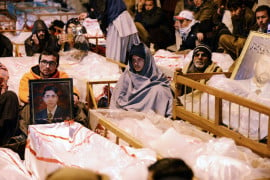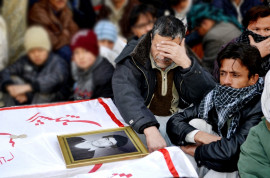
On January 10, two massive suicide bombs exploded at a snooker hall in the Alamdar Road area of Quetta, Balochistan, killing around 100 people. The scale of the destruction and loss of life have shocked Pakistan. The attack has also focused attention on the continued persecution of Shia Muslims, particularly those from the Hazara community.
The Alamdar Road area is an enclave on the edge of the city, almost entirely inhabited by the Hazaras, a Persian-speaking Shia minority who emigrated from Afghanistan more than 100 years ago. It is a ghettoised ethnic enclave where armed Hazara men stand guard outside businesses, many of which moved out here from the city centre. The reason for this tight security is the climate of fear, borne of an increasingly intense campaign of violence by Sunni militant groups.
The incidents speak for themselves. On October 4 in Quetta, gunmen on motorbikes stopped a bus carrying mainly Hazara Shias, who were on their way to work at a vegetable market. The attackers forced the passengers off the bus, lined them up and shot them. Thirteen people were killed and six injured. On September 19 in Mastung, Balochistan, gunmen intercepted a bus of about 40 pilgrims travelling to Iran to visit Shia holy sites. Some escaped; others did not. Twenty-six people were shot dead and six wounded. The attack on the pilgrims was carried out by the Lashkar-e-Jhangvi (LeJ), the militant organisation which has claimed responsibility for the snooker hall bombs. In addition to these massacres, there is a steady trickle of sectarian murders: shopkeepers or mechanics killed as they go about their daily duties, men executed on the street. The attacks take place in broad daylight. Reportedly, the gunmen frequently do not even bother to disguise their identity, knowing that they need not fear arrest or serious repercussions.
The upsurge in violence against the Hazaras is part of a wider surge in sectarian violence across Pakistan, as long-standing Sunni militant groups and newer elements, such as the Taliban, both act on their poisonous anti-Shia ideology. According to the Human Rights Watch (HRW), 375 Shias died in 2012, with at least 100 of those from the Hazara community. This was the deadliest year for Shias in Pakistan in decades. In Balochistan, where 500,000 Hazaras live, the group has found itself the primary target of militant groups such as the LeJ. The Hazaras’ distinctive Central Asian appearance marks them out as an easy target. According to figures released by the Balochistan government, 758 Shias have been killed in the province between 2008 and 2012. Members of the Hazara community say the true figure is much higher.
Perhaps, the most disturbing fact is that nothing has been done to protect this beleaguered community. In the aftermath of last week’s bombs, the HRW has condemned the authorities for ‘turning a blind eye’ to the activities of militant organisations. “They [Hazaras] live in a state of siege. Stepping out of the ghetto means risking death,” the HRW’s Pakistan Director, Ali Dayan Hasan, has said. “Everyone has failed them — the security services, the government, the judiciary.” January 10’s attacks demonstrated that even staying within the ghetto is not safe: the assailants will come to them.
Shia leaders in Quetta have demanded that the army be sent in to protect them, saying that the dead from the bomb attacks cannot be buried until this demand is met. The desperation is palpable.
The problem here, as always when discussing militancy in Pakistan, is the ambivalence of the authorities. Successive governments have allowed these groups to flourish, using them to serve state interests in Kashmir or Afghanistan. While the military formally ended its relationship with organisations like the LeJ in 2001, this group, and others, which are supposedly banned, continue their activities with near impunity. The audacity and frequency of attacks on the Hazaras in Balochistan indicate that militants are unconcerned about being apprehended. The group’s leader, Malik Ishaq, was released from prison last year to showers of rose petals from supporters, and lives openly in southern Punjab. Local Shia community leaders in Quetta allege that the police are colluding with militants, a charge which is strenuously denied. It would be difficult to dispute, however, that the authorities, at the very least, are turning a blind eye. Although the police claim to have apprehended dozens of suspects in the murder of Shias, none have been charged. No one has been seriously held to account.
The extremist threat affects the entire population. This is evident from the fact that the very same day as the snooker hall bombings, 22 people died in an explosion at a Sunni religious gathering in Swat. But the brutality with which the Hazaras are being targeted and massacred is on a different scale. To be marked out as a target simply by one’s face, one’s language, is a reality too frightening for most of us to imagine. Many Hazaras have fled to Australia, which is home to a substantial diaspora community. The journey, in the hands of people smugglers, is both expensive and dangerous; it is not unusual for boats to sink en route across the Indian Ocean. Even if they do complete the journey, an uncertain future awaits them. But given that simply going to work, taking a bus or stepping out of the house can mean death in their home city, it is easy to understand why some take this option.
This is not just about one community. “The ongoing targeted killings of Shia send a chilling message to all Pakistanis that their government will not necessarily act to protect them,” says Brad Adams, Asia director of the HRW. The increasing violence of militant groups against minority communities should be of concern to every citizen: it is simply one marker of their confidence and manpower. As the Hazara graveyard in Quetta fills up, with a special area dedicated for victims of targeted killings already being expanded, we must ask: how much more will it take for something to be done?
Published in The Express Tribune, January 14th, 2013.
Correction: An earlier version of this article erroneously mentioned Alamdar Road as Alamgir Road. The error is regretted.
COMMENTS (12)
Comments are moderated and generally will be posted if they are on-topic and not abusive.
For more information, please see our Comments FAQ



















































"Very well said Sir. You do have a solution for everyone of our ills. Will you please check if they are practicable? For instance, how can Pakistan be Secular, if Pakistanis’ majority is Nonsecular?" Germans were also non secular fascist under Hitler.Japanies were also non democratic under Hirohito, whom they worshiped like god.Every nation at some point was non secular.Point is who rules makes own priciples of governance.Pakistan is unfortunately,from its begining, run by non democratic forces which can not justify their role unless they mislead the nation with self concocted theories.It was the bloodshed which turned many nation secular.Pakistan story is not going to be different.Bloodshed has taken its roots already.Let us see at what point we learn the lesson.Pakistan is definetly going to be a secular Islamic state believe me.And see that there is a difference between Islamic state and Muslim state. Cheers.
Alamdar RD or Alamgir RD. Does it really matter? Whats important is that Pakistan should protect the Shias, specially the Hazaras as they are also 100% Pakistanis. Someone should totally crush LEJ and like minded parties.
It is ALAMDAR ROAD, not Alamgir Road. Shows how much the author knows Quetta.
@wonderer: I think what @sabi means by secular is the separation of religion from the working of the State. This does not mean that the state would have no religion, as is erroneously and mischievously construed.
@sabi:
Very well said Sir. You do have a solution for everyone of our ills. Will you please check if they are practicable? For instance, how can Pakistan be Secular, if Pakistanis' majority is Nonsecular?
Thanks for writing for the voiceless people of Pakistan.
The are written 'Alamgir Road' is wrong. That is 'Alamdar road'.
I wish the events in Quetta did not inspire such thoughtful insight and comments. That oft repeated adage of 'and then they came for me, and there was no one......' is becoming true in our society as one section of society after another is being targeted. Next it will be the various sects within the Sunnis - the Deobandis, Hanfis, Wahabbis etc. To think that most Pakistanis were okay when the Christians and the Hindus were being 'cleansed', now we will eventually ALL have to be spiritually and physically bathed, washed, cleansed but perhaps left untended and unburied like the hundreds of those innocents killed and injured in Quetta. Right now, sayings such as ' religion teaches us tolerance ..... ' and 'ours is a religion of peace......' seem like a sick joke. Words are indeed beginning to fail us and are slowly becoming obsolete and meaningless. What will we run out of first: humanity, bodies, empathy, opinions, life .......? Let's hope it's humanity first - then we just won't care for our fellow beings. Take these animals' example, they seem to sleep okay after their dastardly deeds, while the rest of us have sleepless nights, and stomach churning days.
Genocide! After the Bengali citizens it is the turn of the Shia, Ahemedis and Hindus. The LEJ, with the silent support of the majority, is accelerating Pakistan's march to purity.
An influential group in Pakistan has decided to assert their supremacy over the entire country and to establish their hegemonic designs they are targeting weak minority groups. Shia, Hindus, Christians, Ahmedis and Sufi shrines are their easy targets, since the state has made deals with these groups in the past they believe by ignoring these acts of violence things will eventually simmer down. This makes the extremist LEJ/SSP primary culprits but this also means that State and its functionary organs are accessories in this crime. If we wish to change our future, then it is imperative to bring down these sanctioned religious extremists and show the people what justice really means.
Establishment should wind up it policy of safeguarding ideaological boundries,deal evry ressistance with iron hand and make Pakistan a secular state.The nation has lost its good values and it's existance it threatened now.Key to the solution is,doing away with deadly theocratic mindset.Say good bye to zia and ZAB constitution before it finaly sink the ship.
thanks God someone remembered those tablighis in swat also.
There is no such Alamgir Road in Quetta. Rather it is Alamdaar Road. The editor should have edited this mistake.